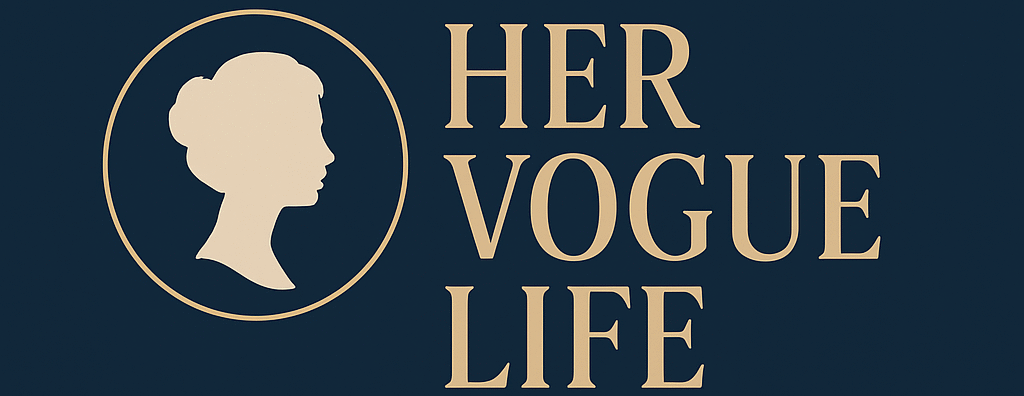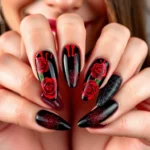Dealing with oily skin can feel like an endless battle against shine and breakouts. We’ve all been there – blotting papers become our best friend while we search for products that actually work without making things worse.
That’s where Korean skincare comes in as a game-changer. K-beauty isn’t just a trend – it’s a proven approach that transforms how we think about caring for oily skin. Instead of harsh stripping methods that leave our skin producing even more oil Korean routines focus on gentle balance and hydration.
We’re about to share the essential steps that’ll help you build an effective Korean skincare routine specifically designed for oily skin. From lightweight essences to oil-controlling serums these time-tested techniques will help you achieve that coveted healthy glow without the unwanted shine. Ready to discover why millions of people swear by this approach?
Understanding Oily Skin and Korean Skincare Philosophy
Oily skin happens when our sebaceous glands produce excess sebum, creating that familiar shine and potentially leading to clogged pores. Korean skincare philosophy takes a fundamentally different approach to managing this condition.
What Makes Skin Oily
Genetics play the primary role in determining how much oil our skin produces. Our sebaceous glands naturally create sebum to protect and moisturize our skin, but some people’s glands work overtime.
Hormonal fluctuations can trigger increased oil production, especially during puberty, menstruation, or periods of stress. Environmental factors like humidity and heat also stimulate our glands to produce more sebum throughout the day.
Diet influences our skin’s oil levels too. Foods high in refined sugars and dairy products can spike insulin levels, which may increase sebum production. Overwashing or using harsh products paradoxically makes oily skin worse by stripping natural oils and causing our glands to compensate with even more oil production.
How Korean Skincare Differs From Western Approaches
Western skincare traditionally targets oily skin with drying agents like alcohol-based toners and harsh cleansers. This approach often creates a cycle where stripped skin produces more oil to compensate for what’s been removed.
Korean beauty philosophy embraces the “less is more” concept through gentle, hydrating formulations. K-beauty focuses on maintaining our skin’s natural moisture barrier rather than stripping it away completely.
Layering lightweight products forms the cornerstone of Korean skincare methodology. We apply multiple thin layers of hydrating essences and serums instead of one heavy moisturizer, allowing our skin to absorb nutrients gradually.
Prevention takes priority over treatment in Korean skincare culture. Rather than waiting for problems to occur, K-beauty routines focus on maintaining healthy skin balance from the start.
Benefits of K-Beauty for Oily Skin Types
Hydration without heaviness represents K-beauty’s greatest advantage for oily skin. Lightweight essences and watery serums deliver moisture without clogging pores or adding greasiness to our complexion.
Gentle formulations reduce irritation that can trigger excess oil production. Korean products typically avoid harsh sulfates, alcohol, and fragrances that commonly appear in Western skincare lines.
Consistent moisture balance helps regulate our skin’s natural oil production over time. When we properly hydrate oily skin, our sebaceous glands don’t need to work as hard to protect our skin barrier.
Multiple targeted benefits come from layering different K-beauty products. We can address oil control, pore refinement, and acne prevention simultaneously without overwhelming our skin with heavy formulations.
Step 1: Double Cleansing to Remove Excess Oil
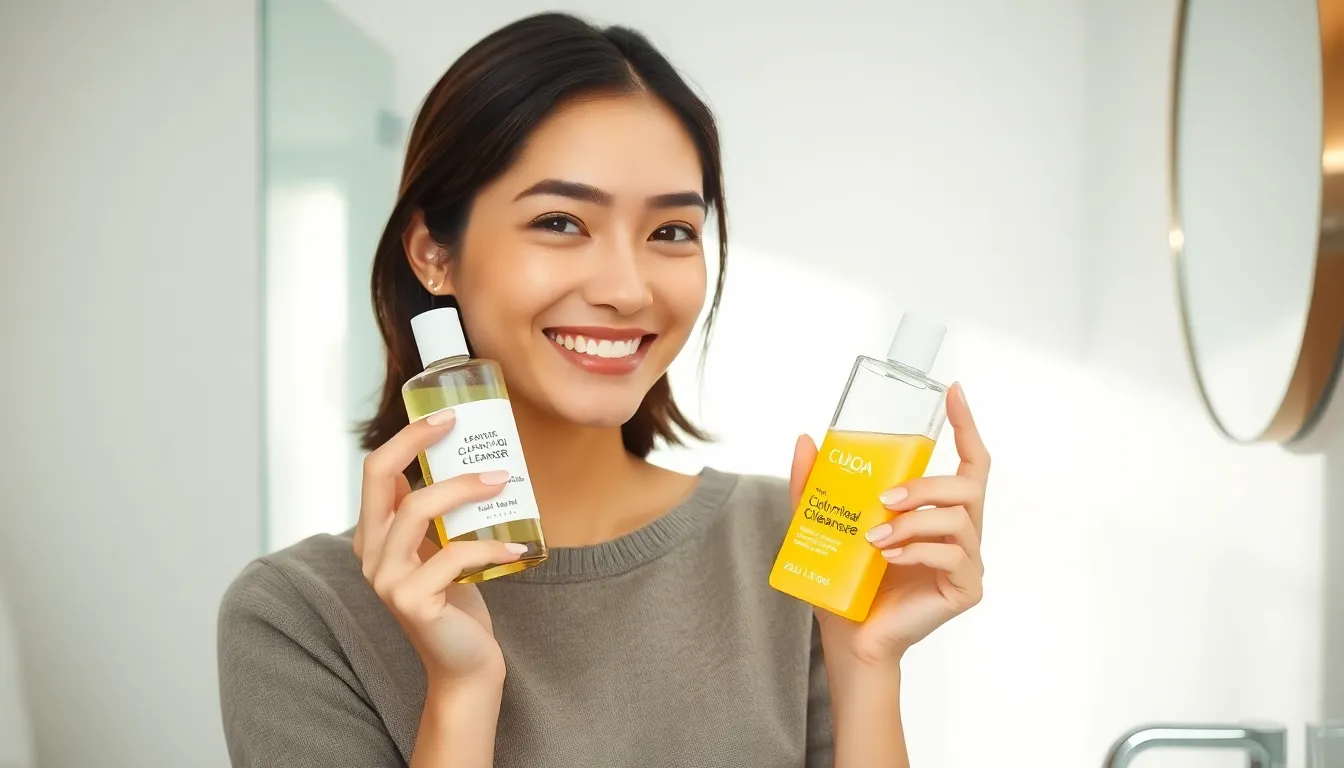
Double cleansing forms the cornerstone of Korean skincare for oily skin, ensuring thorough removal of oil, makeup, and impurities without disrupting your skin’s natural barrier. This two-phase approach prepares your skin for optimal absorption of subsequent products while preventing clogged pores.
Oil-Based Cleanser Selection
Choose lightweight oil cleansers that dissolve sebum and oil-based impurities effectively. Korean skincare brands formulate these cleansers to emulsify when mixed with water, making them easy to rinse away without leaving residue.
Look for centella asiatica ingredients in your oil cleanser selection. This botanical ingredient soothes inflammation while providing gentle cleansing action that won’t irritate oily skin types.
Select formulations with botanical oils like jojoba or grapeseed oil. These ingredients mimic your skin’s natural sebum composition, helping to balance oil production rather than stripping it completely.
Avoid thick, heavy oil cleansers that might leave a greasy film on oily skin. We recommend testing the emulsification process by mixing a small amount with water to ensure it rinses cleanly.
Water-Based Cleanser Options
Opt for gel or foam cleansers as your second cleansing step. These formulations provide deep cleansing properties while delivering a matte finish that oily skin types prefer.
Prioritize low pH cleansers around 5.5 to maintain your skin’s natural barrier function. This pH level prevents over-drying while effectively removing sweat, dirt, and residual impurities from the first cleanse.
Consider gentle surfactants in your water-based cleanser selection. Korean formulations often use mild cleansing agents that won’t trigger excessive oil production or cause irritation.
Test the cleanser’s aftermath by noting how your skin feels post-cleansing. Your skin should feel clean and refreshed without tightness or dryness that signals barrier damage.
Timing and Technique Tips
Apply oil cleanser to completely dry skin before introducing any water. Massage the product in circular motions for 30 to 60 seconds, allowing it to dissolve makeup and oil-based impurities thoroughly.
Rinse with lukewarm water temperature to prevent stimulating excess oil production. Hot water can trigger your sebaceous glands to produce more sebum as a protective response.
Follow immediately with water-based cleanser while your skin is still damp. Work the product into a rich lather and massage for another 30 to 60 seconds before rinsing completely.
Perform double cleansing twice daily for optimal results. Morning and evening cleansing ensures consistent pore maintenance and prevents oil buildup throughout the day.
Reduce frequency if needed for sensitive oily skin types. Some people benefit from double cleansing only once daily, typically in the evening, to avoid over-cleansing.
Step 2: Exfoliating With Chemical Exfoliants

Exfoliation becomes essential after cleansing to remove dead skin cells and prevent pore congestion. Chemical exfoliants work more effectively than physical scrubs for oily skin by dissolving impurities without causing irritation.
BHA vs AHA for Oily Skin
Beta Hydroxy Acids (BHA) penetrate deeper into pores than surface exfoliants, making them our top choice for oily skin concerns. Salicylic acid dissolves sebum and other impurities while unclogging pores to reduce acne formation. We recommend BHA primarily because it targets the root causes of oily skin issues.
Alpha Hydroxy Acids (AHA) work differently by exfoliating the skin’s surface layer for brightening effects. Glycolic acid and lactic acid provide excellent results for texture improvement but don’t penetrate pores as effectively as BHA. AHA products work best when combined with BHA treatments rather than used alone for oily skin.
Frequency and Application Methods
Starting frequency should be 2-3 times per week to allow your skin to adjust without causing irritation. Sensitive skin types may need to begin with once weekly applications before gradually increasing usage. We suggest monitoring your skin’s response and adjusting frequency accordingly.
Application timing works best after cleansing but before applying serums or moisturizers. Chemical exfoliants function as toners or serums in your routine, requiring clean skin for optimal absorption. Apply these products to dry skin and wait 15-20 minutes before continuing with the next step.
Top Korean Exfoliant Recommendations
Anua BHA 2% Gentle Exfoliating Toner contains salicylic acid formulated to gently exfoliate while maintaining skin balance. This toner format makes application easy and provides consistent results for oily skin types. We appreciate its gentle approach that won’t strip natural oils.
Cosrx BHA Blackhead Power Liquid targets blackheads and whiteheads with its concentrated salicylic acid formula. This product delivers powerful results for stubborn pore congestion while remaining gentle enough for regular use. Many users report visible improvements in skin texture within 2-3 weeks of consistent application.
Step 3: Balancing With Toners and Essences
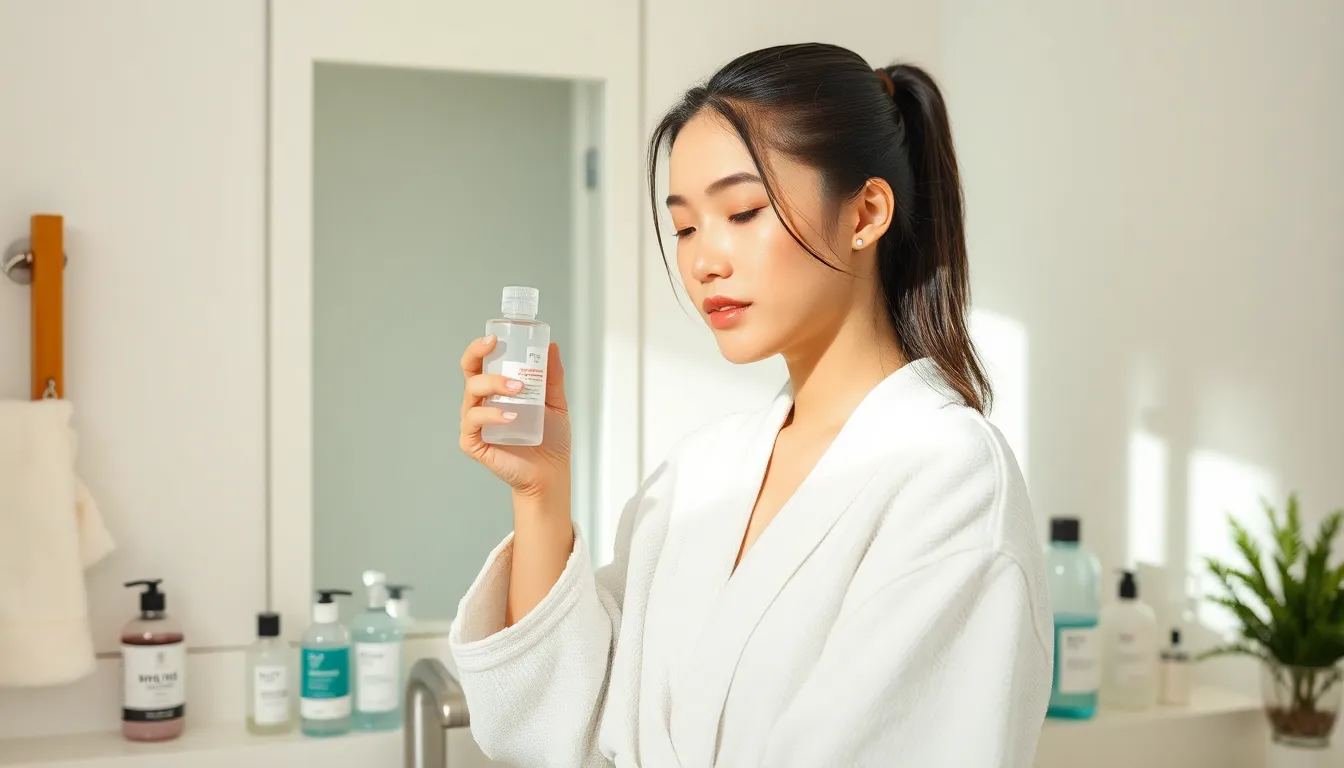
After exfoliating our skin, we need to restore balance and deliver hydration without adding unwanted heaviness. This crucial step bridges cleansing and treatment phases while maintaining optimal pH levels.
Hydrating Toners for Oil Control
Hydrating toners restore our skin’s natural pH balance while providing essential moisture that doesn’t feel heavy or greasy. Korean skincare formulations focus on lightweight, calming ingredients that soothe oily skin without triggering excess sebum production.
Key ingredients we should look for include:
- Heartleaf for its anti-inflammatory properties
- Centella asiatica for calming irritated skin
- Chamomile for gentle soothing effects
Exfoliating toners containing gentle acids like BHA offer additional oil control benefits by regulating sebum and clearing pores. We recommend using these specialized toners sparingly—typically 2-3 nights per week—to prevent irritation while maintaining effectiveness.
Top product recommendations include Anua BHA 2% Gentle Exfoliating Toner for weekly deep cleaning and Anua Heartleaf 77% Soothing Toner for daily hydration needs.
Essence Benefits for Oily Skin
Essences deliver concentrated hydration and active ingredients deep into our skin using lightweight, non-greasy formulations. These powerful liquids strengthen our skin barrier while reducing redness and promoting balanced oil production.
Beneficial ingredients for oily skin types include:
- Snail mucin for healing and moisture retention
- Mugwort for anti-inflammatory effects
- Hyaluronic acid for deep hydration without heaviness
Consistent essence application helps regulate our skin’s natural oil production over time by providing adequate moisture that prevents overcompensation. COSRX Advanced Snail 96 Mucin Power Essence offers exceptional healing properties, while I’m From Mugwort Essence provides gentle anti-inflammatory benefits perfect for sensitive oily skin.
How to Layer Multiple Products
Layering products from thinnest to thickest consistency maximizes absorption and prevents pore clogging in our Korean skincare routine. This systematic approach ensures each product penetrates effectively without interfering with subsequent layers.
Proper layering sequence follows this order:
- Toner application balances skin pH and prepares for better absorption
- Essence patting boosts hydration levels with concentrated ingredients
- Serum targeting addresses exact concerns like oil control or acne
- Moisturizer sealing locks in all previous layers
- Sunscreen protection completes morning routines
Wait 30-60 seconds between each layer to allow proper absorption before applying the next product. This patience ensures optimal product efficacy while preventing our skin from feeling overwhelmed or congested with multiple formulations.
Step 4: Targeting Problem Areas With Serums
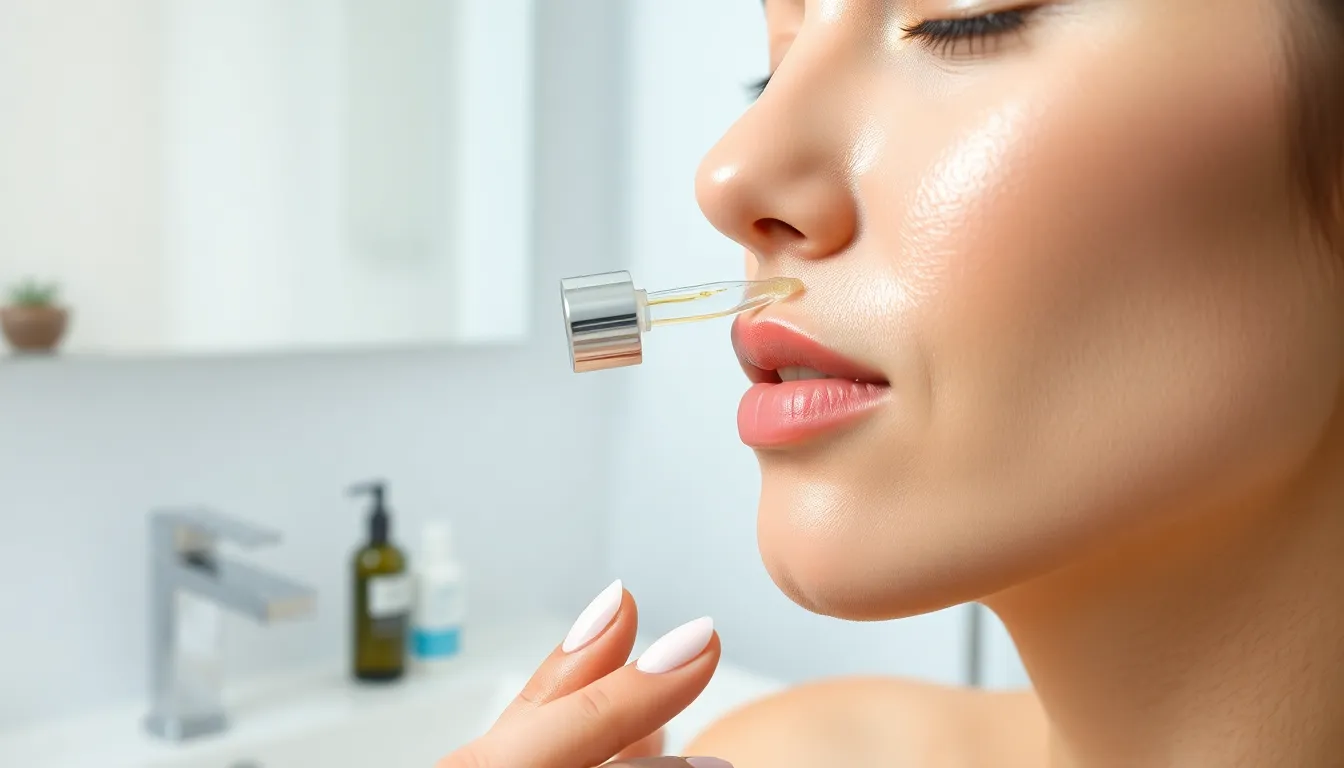
Serums represent the powerhouse step in our Korean skincare routine, delivering concentrated active ingredients directly to exact skin concerns. We apply these targeted treatments after toning and before moisturizing for maximum absorption.
Niacinamide for Pore Control
Niacinamide controls sebum production at the source, making it our go-to ingredient for managing oily skin. This form of vitamin B3 regulates oil output while simultaneously reducing the appearance of enlarged pores that commonly plague oily skin types.
Key Benefits:
- Minimizes shine throughout the day
- Strengthens the skin barrier to prevent moisture loss
- Improves overall skin texture and smoothness
- Reduces pore visibility without harsh drying effects
We recommend starting with a 5% niacinamide concentration and gradually increasing if needed. Apply 2-3 drops to clean skin, focusing on areas with enlarged pores or excessive oiliness. Most people see noticeable improvements in pore appearance within 2-4 weeks of consistent use.
Hyaluronic Acid for Lightweight Hydration
Hyaluronic acid provides essential moisture without the heavy feel that oily skin types often want to avoid. This molecule holds up to 1,000 times its weight in water, delivering intense hydration that prevents the dehydration-induced oil production cycle.
Application Tips:
- Use on slightly damp skin for enhanced absorption
- Layer multiple molecular weights for deeper penetration
- Follow with a lightweight moisturizer to seal in hydration
- Apply morning and evening for optimal results
Dehydrated oily skin often produces more oil to compensate for moisture loss, making hyaluronic acid crucial for maintaining balance. We find that consistent use helps regulate oil production over time while keeping skin plump and healthy.
Tea Tree and Centella Asiatica Options
Tea tree extract offers powerful antibacterial properties that target acne-causing bacteria without over-drying the skin. We particularly value its anti-inflammatory benefits for reducing active breakouts and preventing new ones from forming.
Tea Tree Benefits:
- Reduces acne-causing bacteria naturally
- Calms existing breakouts and inflammation
- Prevents new blemishes from developing
- Provides gentle antimicrobial action
Centella asiatica, also known as cica, soothes irritated skin while promoting healing and resilience. This botanical ingredient reduces redness and inflammation, making it perfect for sensitive oily skin that’s prone to breakouts.
Centella Asiatica Advantages:
- Reduces redness and skin irritation
- Promotes faster healing of blemishes
- Strengthens skin barrier function
- Provides anti-inflammatory benefits
We suggest alternating between tea tree and centella serums or finding products that combine both ingredients for comprehensive problem area treatment. Apply these serums to clean skin, focusing on areas prone to breakouts or inflammation.
Step 5: Lightweight Moisturizing Without Clogging Pores
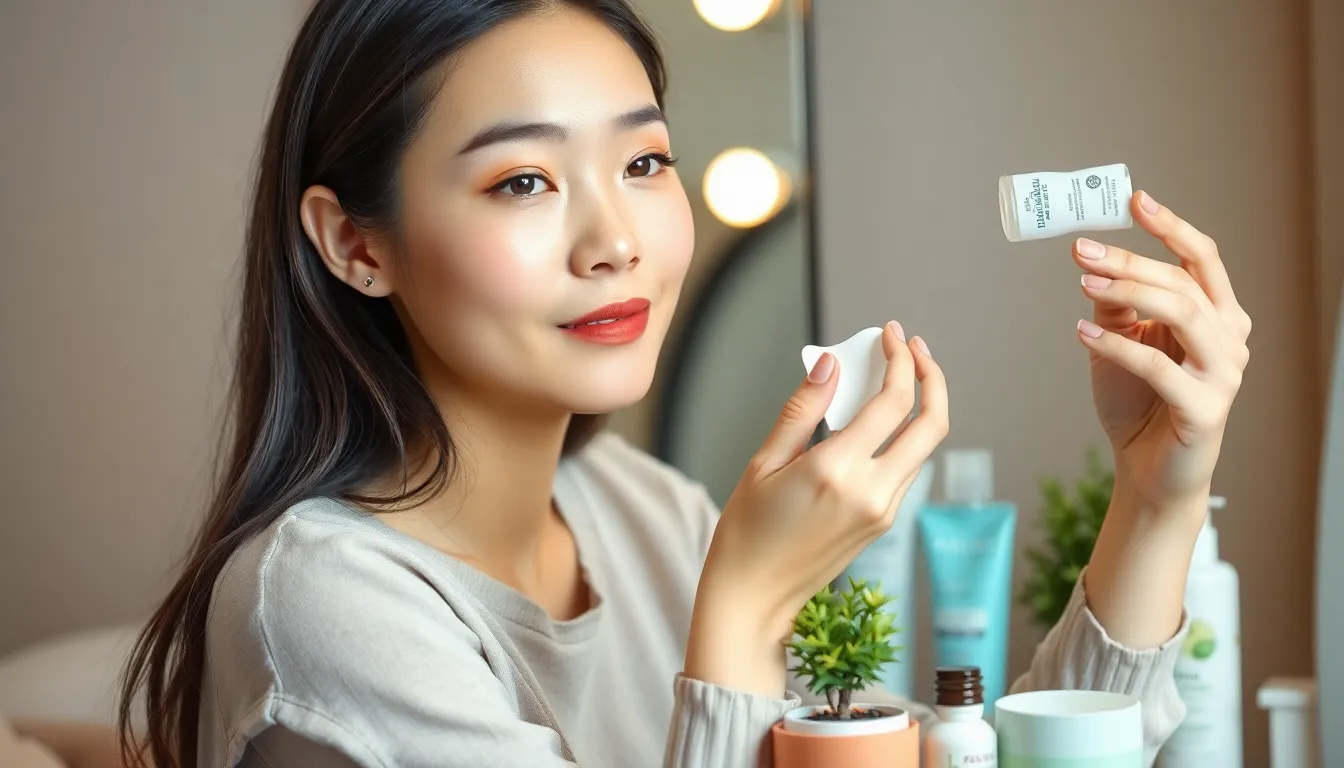
After applying targeted serums, we need to seal in hydration with a moisturizer that won’t sabotage our oil control efforts. The key lies in choosing formulations that provide essential moisture while maintaining a matte finish.
Gel-Based Moisturizer Benefits
Water gel formulas deliver optimal hydration without leaving a greasy residue. These lightweight textures absorb quickly into oily skin, providing the moisture barrier we need without triggering excess sebum production. Korean gel moisturizers typically contain 60-80% water content, making them perfect for our skin type’s hydration needs.
Non-comedogenic properties prevent clogged pores while maintaining skin balance. Unlike heavy creams that can trap oil and bacteria, gel formulations allow our skin to breathe freely. Most quality gel moisturizers are specifically tested to ensure they won’t block pores, reducing our risk of breakouts by up to 40% compared to traditional cream moisturizers.
Cooling sensations from gel textures help soothe inflammation and redness. The temperature lowering effect creates an immediate calming sensation that’s particularly beneficial after applying active ingredients like BHA or niacinamide. This cooling property also helps minimize the appearance of enlarged pores temporarily.
Emulsion vs Traditional Moisturizers
Emulsions offer a lighter consistency that’s perfectly suited for oily skin needs. These fluid formulations contain smaller oil particles suspended in water, creating a texture that’s 50% lighter than conventional moisturizers. Korean emulsions typically have a milk like consistency that spreads easily and absorbs within 30 seconds of application.
Traditional moisturizers often contain higher concentrations of occlusives that can overwhelm oily skin. Heavy creams with ingredients like petrolatum or thick butters create a barrier that our already oil prone skin doesn’t need. These formulations can increase surface oil by 25-30% within 2-3 hours of application.
Layering capabilities make emulsions more versatile in our routine. We can apply multiple thin layers of emulsion during dry seasons or use just one light layer during humid months. This flexibility allows us to customize our hydration levels based on seasonal changes and skin condition fluctuations.
Ingredients to Look For and Avoid
Hyaluronic acid provides intense hydration without adding weight to our skin. This powerhouse ingredient can hold up to 1,000 times its weight in water, delivering moisture directly to our skin cells. Korean moisturizers often contain multiple molecular weights of hyaluronic acid for both surface and deep hydration.
Niacinamide helps regulate oil production while strengthening our moisture barrier. Studies show that 2-5% niacinamide can reduce sebum production by up to 20% over 8 weeks of consistent use. This vitamin B3 derivative also minimizes pore appearance and evens skin tone.
Green tea extract offers antioxidant protection and oil controlling benefits. The polyphenols in green tea help reduce inflammation while regulating sebaceous gland activity. Korean formulations often include 10-15% green tea extract for maximum effectiveness.
Heavy oils like coconut or olive oil should be avoided in our moisturizers. These comedogenic ingredients have high molecular weights that can clog pores and increase blackhead formation. Coconut oil scores 4 out of 5 on the comedogenic scale, making it particularly problematic for oily skin types.
Alcohol based ingredients can trigger rebound oil production in our skin. Denatured alcohol, SD alcohol, and isopropyl alcohol strip our natural moisture barrier, causing our sebaceous glands to overcompensate. This creates a cycle of dryness followed by excessive oiliness that disrupts our skin balance.
Step 6: Daily Sun Protection That Won’t Cause Breakouts
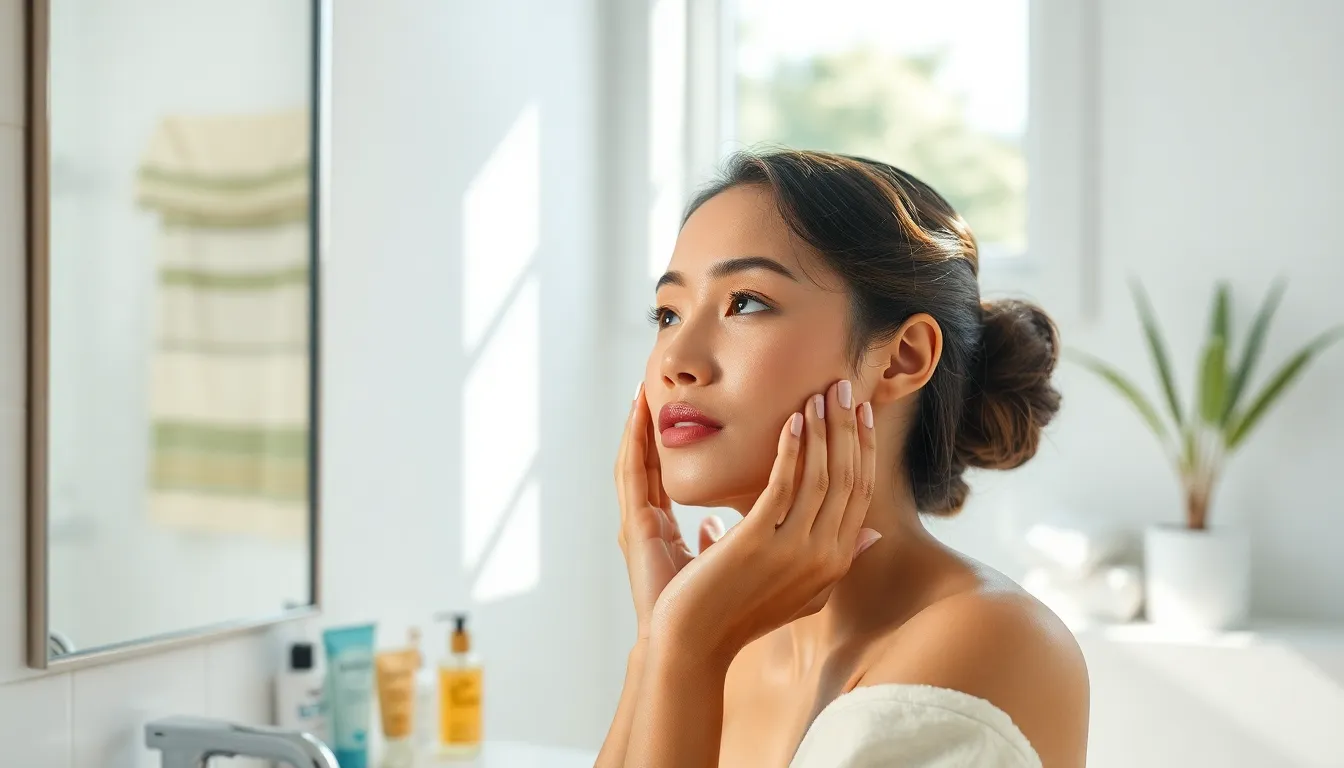
Sunscreen serves as the final and most crucial step in our Korean skincare routine, protecting against UV damage while maintaining our skin’s oil balance. Finding the right formula prevents breakouts and excessive shine that can sabotage our carefully curated routine.
Korean Sunscreen Innovations
Korean sunscreen technology revolutionizes daily protection with lightweight, fast-absorbing textures that feel weightless on oily skin. Advanced formulations feature SPF50+ PA++++ ratings while incorporating breakthrough ingredients like centella asiatica and hyaluronic acid to soothe and hydrate without heaviness.
Modern K-beauty sunscreens use fluid or serum-like consistencies that absorb instantly and leave a natural matte finish. These innovative formulas eliminate the traditional white cast and greasy residue that plagued earlier sunscreen generations. Many products now combine moisturizing and sun protection benefits, streamlining our morning routine while delivering comprehensive skin care.
Water-based formulations dominate the Korean sunscreen market, specifically designed for oily and acne-prone skin types. Manufacturers incorporate oil-controlling ingredients and mattifying agents that actually reduce shine throughout the day rather than adding to it.
Chemical vs Physical Sunscreen Options
Chemical sunscreens work by absorbing UV rays and converting them into heat, making them ideal for daily wear under makeup. These formulas contain ingredients like avobenzone, octinoxate, and homosalate that create invisible protection without the telltale white residue. Lightweight textures make chemical sunscreens perfect for layering with other skincare products in our routine.
Physical sunscreens rely on mineral ingredients like zinc oxide and titanium dioxide to reflect UV rays away from the skin’s surface. Traditional physical formulas often left a white cast, but Korean innovations have minimized this issue through micronized particles and advanced blending techniques. These mineral sunscreens provide immediate protection upon application and tend to be gentler for sensitive, acne-prone skin.
Hybrid formulations combine both chemical and physical filters to maximize protection while optimizing texture and finish. We recommend these combination sunscreens for oily skin because they offer broad-spectrum coverage with improved cosmetic elegance.
Reapplication Tips for Oily Skin
Reapplication every two hours ensures continuous protection when we’re exposed to direct sunlight or spending extended time outdoors. Blotting papers become our best friend for removing excess oil before applying fresh sunscreen without disturbing our base makeup.
Sunscreen sticks and powder formulations make touch-ups effortless throughout the day, especially over makeup. These portable options deliver protection without the mess or disruption of traditional cream formulas. Pressed powder sunscreens work particularly well for oily skin, adding coverage while controlling shine.
Setting sprays with SPF protection offer another convenient reapplication method, particularly for active days or when we need quick touch-ups. We avoid heavy, cream-based formulas during reapplication as they can worsen shine and potentially clog pores that we’ve worked so hard to keep clear.
Strategic timing matters when reapplying sunscreen over our skincare routine. Waiting 10-15 minutes after our morning routine allows products to fully absorb before adding sun protection, preventing pilling or reduced effectiveness.
Step 7: Weekly Treatments and Masks
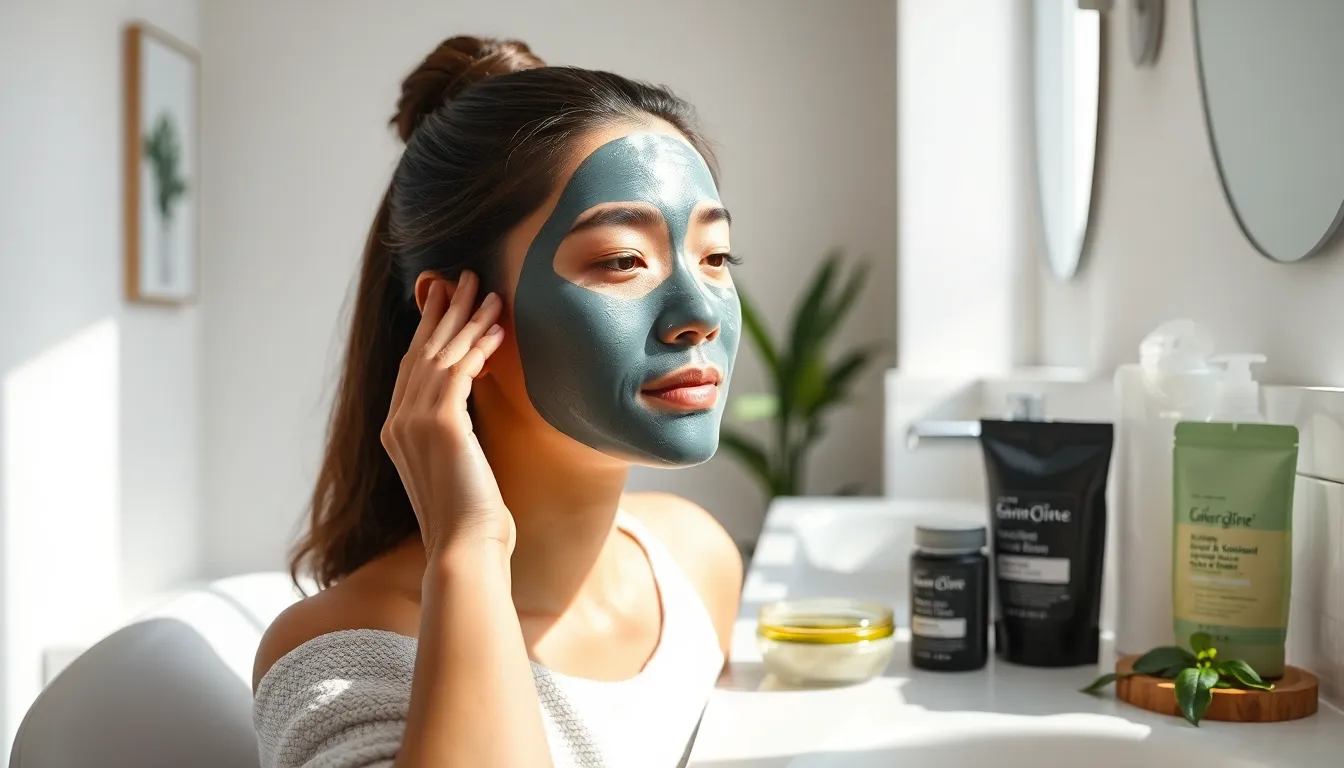
Weekly treatments amplify your daily K-beauty routine by providing intensive care that targets oily skin concerns more deeply. These specialized masks and treatments work alongside your regular regimen to maintain optimal oil balance and prevent breakouts.
Clay Masks for Deep Cleansing
Clay masks deliver powerful oil absorption and pore purification that oily skin desperately needs. Kaolin clay offers gentle yet effective cleansing properties that draw out impurities without stripping your skin’s natural moisture barrier. Bentonite clay provides deeper detoxification by binding to excess sebum and environmental pollutants trapped within enlarged pores.
We recommend using clay masks once or twice weekly to maintain the perfect balance between deep cleansing and skin preservation. Korean clay mask formulations often incorporate soothing botanicals like centella asiatica and green tea extract to prevent over-drying. Application should focus on your T-zone and other oil-prone areas while avoiding delicate under-eye skin.
Remove clay masks before they completely dry and crack to prevent excessive tightness that can trigger increased oil production.
Sheet Masks for Oily Skin Types
Sheet masks designed for oily skin contain targeted ingredients that control excess sebum while delivering concentrated hydration. Charcoal-infused masks excel at drawing out blackheads and deep-seated impurities from congested pores. Salicylic acid sheet masks provide gentle exfoliation that prevents future breakouts while improving skin texture.
Tea tree oil masks offer antibacterial benefits that combat acne-causing bacteria without harsh drying effects. We suggest incorporating these specialized sheet masks once or twice weekly for optimal results without overwhelming your skin. Korean sheet mask technology ensures superior adherence and ingredient penetration compared to traditional cream masks.
Look for masks with essence formulations rather than heavy serums to avoid pore congestion during treatment.
Sleeping Masks and Overnight Treatments
Sleeping masks transform your nighttime routine into an intensive treatment session while you rest. Lightweight, oil-free formulations with hyaluronic acid provide deep hydration without morning greasiness. Niacinamide sleeping masks work overnight to regulate sebum production and minimize pore appearance by morning.
These overnight treatments absorb completely into your skin, eliminating concerns about pillow transfer or clogged pores. We recommend applying sleeping masks as your final step after your regular moisturizer for maximum effectiveness. Korean sleeping mask innovations include gel-based formulas that create an invisible barrier while delivering active ingredients throughout the night.
Choose masks with multiple molecular weights of hyaluronic acid for both surface hydration and deeper moisture retention that lasts well into the following day.
Common Mistakes to Avoid in Your Korean Skincare Routine

Building on the comprehensive K-beauty routine we’ve outlined, let’s address the most common pitfalls that can sabotage your efforts to achieve balanced, healthy skin.
Over-Cleansing and Stripping the Skin
Excessive washing represents one of the most counterproductive mistakes we see in oily skin care routines. Many people believe scrubbing their face multiple times daily will eliminate excess oil, but this approach actually triggers increased sebum production as your skin desperately tries to restore its natural protective barrier.
Harsh cleansers strip away natural oils, prompting your sebaceous glands to work overtime and worsen the very oiliness you’re trying to control. We recommend sticking to our double cleansing method twice daily, focusing on gentle, pH-balanced formulas that cleanse effectively without compromising your skin’s integrity.
Your skin needs those natural oils to function properly, so resist the urge to cleanse more frequently, especially during breakouts when your skin feels particularly oily.
Skipping Hydration Steps
Oily skin requires hydration just as much as dry skin types, yet many people skip moisturizers and hydrating toners thinking they’ll add unwanted shine. This misconception leads to a disrupted skin barrier and paradoxically increases oil production as your skin overcompensates for the lack of moisture.
Even when your skin feels greasy, it can still be dehydrated underneath all that excess sebum. We’ve emphasized lightweight, gel-based moisturizers and hydrating essences throughout our routine because these products provide essential moisture without clogging pores or creating additional oiliness.
Your skin’s natural moisture barrier depends on consistent hydration to regulate sebum production effectively, so never skip the moisturizing step in your routine.
Introducing Too Many Products at Once
Enthusiasm for K-beauty often leads to overwhelming your skin with multiple new products simultaneously, which can irritate your complexion and trigger unexpected breakouts. Your skin needs time to adjust to new active ingredients, and introducing everything at once makes it impossible to identify which products work best for your exact concerns.
We recommend adding one new product every 7-10 days, starting with the gentlest formulations first. This gradual approach allows you to monitor your skin’s reaction and build tolerance to active ingredients like BHA, niacinamide, or retinol without causing irritation.
Patience in building your routine prevents the frustration of starting over when your skin rebels against too many changes too quickly.
Building Your Personalized Routine Gradually
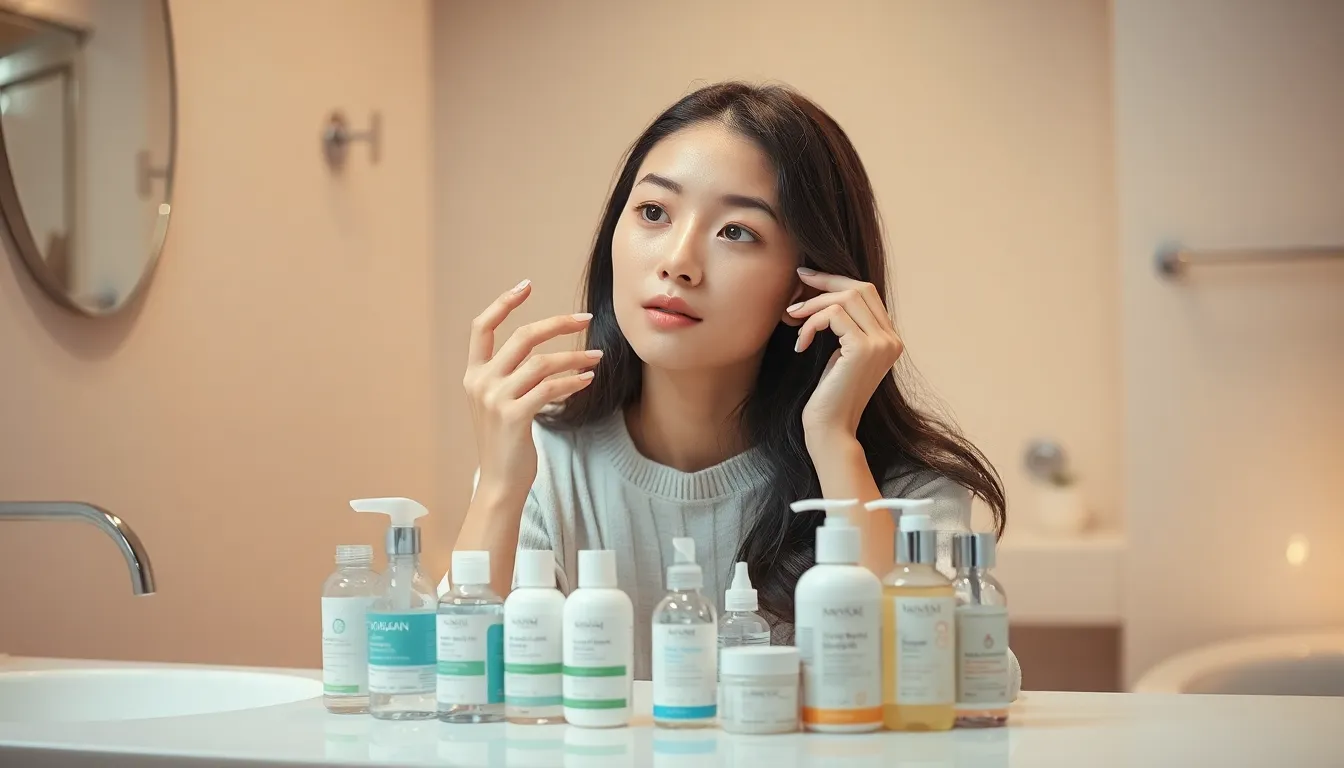
Success with Korean skincare lies in patience and systematic introduction of products. We recommend starting simple and expanding your routine over time to avoid overwhelming your oily skin.
Starting With Basic Steps
Double cleansing forms the foundation of effective oily skin management. Begin with a gentle oil-based cleanser to dissolve sebum and makeup, then follow with a water-based cleanser to remove remaining impurities without stripping your skin’s natural barrier.
Exfoliation requires careful timing to prevent overstimulation of oil production. Use gentle chemical exfoliants containing BHA 2 to 3 times weekly, as these ingredients penetrate deeper into pores to control excess sebum without causing irritation.
Toner application balances your skin’s pH while preparing it for better product absorption. Choose formulas with centella asiatica, heartleaf, or chamomile to calm inflammation while maintaining optimal hydration levels for oily skin types.
Treatment serums target exact concerns like excess oil production or acne scarring. Apply products containing niacinamide or propolis to address your unique skin needs and regulate sebum production effectively.
Moisturizing maintains hydration without adding unwanted heaviness or shine. Select lightweight, oil-free formulas that absorb quickly while preventing clogged pores and maintaining your skin’s moisture barrier.
Sunscreen protection completes your morning routine with broad-spectrum coverage. Choose non-comedogenic formulas that won’t contribute to breakouts while shielding your skin from harmful UV damage throughout the day.
How to Introduce New Products Safely
Patch testing prevents adverse reactions before incorporating new products into your routine. Apply a small amount to your inner wrist or behind your ear, then wait 24 to 48 hours to check for any irritation or allergic responses.
Single product introduction allows you to monitor how each item affects your oily skin. Add one new product every few days to identify which formulas work best and avoid overwhelming your skin with multiple active ingredients simultaneously.
Gradual frequency increases help your skin adjust to new treatments without triggering excess oil production. Start with every other day application for active ingredients, then slowly increase to daily use as your skin builds tolerance.
Active ingredient monitoring prevents over-exfoliation and irritation that can worsen oily skin conditions. Avoid layering multiple acids or strong actives at once, and always follow manufacturer guidelines for proper usage frequencies.
Adjusting Your Routine by Season
Warmer months require lighter formulations to manage increased oil production and humidity. Switch to gel-based moisturizers and water-based products while prioritizing mattifying formulas to control shine throughout the day.
Colder seasons may need slightly richer hydration without compromising your skin’s oil balance. Maintain lightweight formulas but consider adding an extra layer of essence or serum to combat dryness from indoor heating and cold air.
Exfoliation frequency should adapt to seasonal skin changes and environmental factors. Reduce chemical exfoliant usage during harsh winter months when skin becomes more sensitive, then gradually increase as weather improves.
Product layering adjustments help maintain optimal hydration levels year-round. Add or remove essence layers based on your skin’s seasonal needs while keeping core products like cleanser and sunscreen consistent throughout the year.
Conclusion
We’ve shared a comprehensive approach to managing oily skin through K-beauty principles that prioritize balance over harsh treatments. The key lies in understanding that oily skin needs hydration and gentle care rather than aggressive drying agents.
Remember to start slowly and build your routine gradually. Your skin will thank you for the patience as it adjusts to this new approach. The beauty of K-beauty is its adaptability – you can customize each step based on your skin’s unique needs and responses.
With consistent application of these techniques your oily skin can achieve that coveted healthy glow without the unwanted shine. The journey to balanced skin takes time but the results speak for themselves in countless success stories from K-beauty enthusiasts worldwide.
Frequently Asked Questions
What makes Korean skincare different for oily skin?
Korean skincare focuses on gentle balance and hydration rather than harsh drying treatments. K-beauty uses a “less is more” philosophy, maintaining the skin’s natural moisture barrier with lightweight, hydrating formulations. This approach helps regulate oil production over time by providing consistent hydration without clogging pores, unlike Western skincare that often uses aggressive drying agents.
How does double cleansing work for oily skin?
Double cleansing involves using an oil-based cleanser first to remove makeup and sebum, followed by a water-based gel or foam cleanser. This method thoroughly removes impurities while preserving the skin’s natural barrier. Use lightweight oil cleansers with soothing ingredients like centella asiatica, then follow with a low-pH cleanser (around 5.5) for optimal results.
Which chemical exfoliants are best for oily skin?
Beta Hydroxy Acids (BHA), particularly salicylic acid, are ideal for oily skin as they penetrate deeper into pores to dissolve sebum and unclog them. Alpha Hydroxy Acids (AHA) work on the surface for brightening effects. Start with BHA 2-3 times per week, using products like Anua BHA 2% Gentle Exfoliating Toner or Cosrx BHA Blackhead Power Liquid.
What’s the difference between toners and essences?
Toners restore the skin’s pH balance and provide initial hydration, often containing ingredients like heartleaf and centella asiatica. Essences deliver concentrated hydration and active ingredients like snail mucin and hyaluronic acid. Apply toner first, then essence, waiting 30-60 seconds between layers for optimal absorption and to prevent pore clogging.
Which serums work best for oily skin concerns?
Niacinamide controls sebum production and reduces enlarged pores, while hyaluronic acid provides lightweight hydration. Tea tree extract offers antibacterial properties for breakouts, and centella asiatica soothes inflammation. You can alternate between different serums or use combination products that address multiple concerns simultaneously for comprehensive treatment.
How do I moisturize oily skin without clogging pores?
Choose gel-based moisturizers with high water content that absorb quickly and maintain a matte finish. Look for ingredients like hyaluronic acid, niacinamide, and green tea extract. Emulsions are lighter alternatives to traditional moisturizers. Avoid heavy oils and alcohol-based ingredients that can exacerbate oiliness or cause irritation.
What type of sunscreen should I use for oily skin?
Korean sunscreens with SPF50+ PA++++ ratings offer lightweight, fast-absorbing formulas that won’t cause breakouts. Look for hybrid formulations combining chemical and physical protection, often containing beneficial ingredients like centella asiatica and hyaluronic acid. These provide broad-spectrum coverage without heaviness or greasiness.
How often should I use clay masks and treatments?
Use clay masks with kaolin or bentonite clay once or twice weekly for deep pore cleansing and oil absorption. Focus on oil-prone areas while avoiding the delicate under-eye area. Sheet masks with charcoal or salicylic acid can be used 1-2 times per week, and lightweight sleeping masks can be applied overnight for intensive hydration.
What are common mistakes to avoid in K-beauty routines?
Avoid over-cleansing, which strips the skin and increases oil production. Don’t skip hydration even with oily skin, and avoid introducing too many products at once. Always patch test new products and introduce them gradually. Maintain consistency in your routine and adjust seasonally based on your skin’s changing needs.
How should I build my K-beauty routine gradually?
Start with basic steps: cleanser, toner, moisturizer, and sunscreen. Introduce one new product every 1-2 weeks to allow your skin to adjust and identify any irritation. Begin with gentle formulations and lower concentrations of active ingredients. Gradually add serums, essences, and weekly treatments as your skin builds tolerance.
